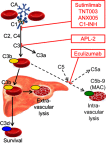Cold agglutinin disease: current challenges and future prospects
- PMID: 31114413
- PMCID: PMC6497508
- DOI: 10.2147/JBM.S177621
Cold agglutinin disease: current challenges and future prospects
Abstract
Cold agglutinin disease (CAD) is a complement-dependent, classical pathway-mediated immune hemolytic disease, accounting for 15-25% of autoimmune hemolytic anemia, and at the same time, a distinct clonal B-cell lymphoproliferative disorder of the bone marrow. The disease burden is often high, but not all patients require pharmacological treatment. Several therapies directed at the pathogenic B-cells are now available. Rituximab plus bendamustine or rituximab monotherapy should be considered first-line treatment, depending on individual patient characteristics. Novel treatment options that target the classical complement pathway are under development and appear very promising, and the C1s inhibitor sutimlimab is currently being investigated in two clinical Phase II and III trials. These achievements have raised new challenges and further prospects, which are discussed. Patients with CAD requiring therapy should be considered for clinical trials.
Keywords: autoimmune hemolytic anemia; cold agglutinin disease; complement; complement inhibitors; lymphoproliferative; therapy.
Conflict of interest statement
S Berentsen has received research support from Mundipharma, travel support from Alexion and Apellis, lecture honoraria from Alexion, Bioverativ, and Janssen-Cilag, and has consulted for Apellis, Bioverativ, Momenta Pharmaceuticals, and True North Therapeutics, outside the submitted work. A Röth has received research support from Alexion and Roche, travel support from Alexion and AbbVie, lecture honoraria from Alexion, Roche, and Novartis, and has consulted for Alexion, Bioverativ, Novartis, and True North Therapeutics, outside the submitted work. U Randen reports no conflicts of interest. B Jilma has received reimbursement for travel for presentations and scientific advice from True North Therapeutics (a Bioverativ Company), outside the submitted work. GE Tjønnfjord has received research support from Mundipharma, Janssen-Cilag and Alexion Pharma, and lecture honoraria from Janssen-Cilag, Alexion Pharma, and Roche Pharma, outside the submitted work.
Figures


References
-
- Berentsen S, Ulvestad E, Langholm R, et al. Primary chronic cold agglutinin disease: a population based clinical study of 86 patients. Haematologica. 2006;91(4):460–466. - PubMed
LinkOut - more resources
Full Text Sources
Other Literature Sources
Miscellaneous

